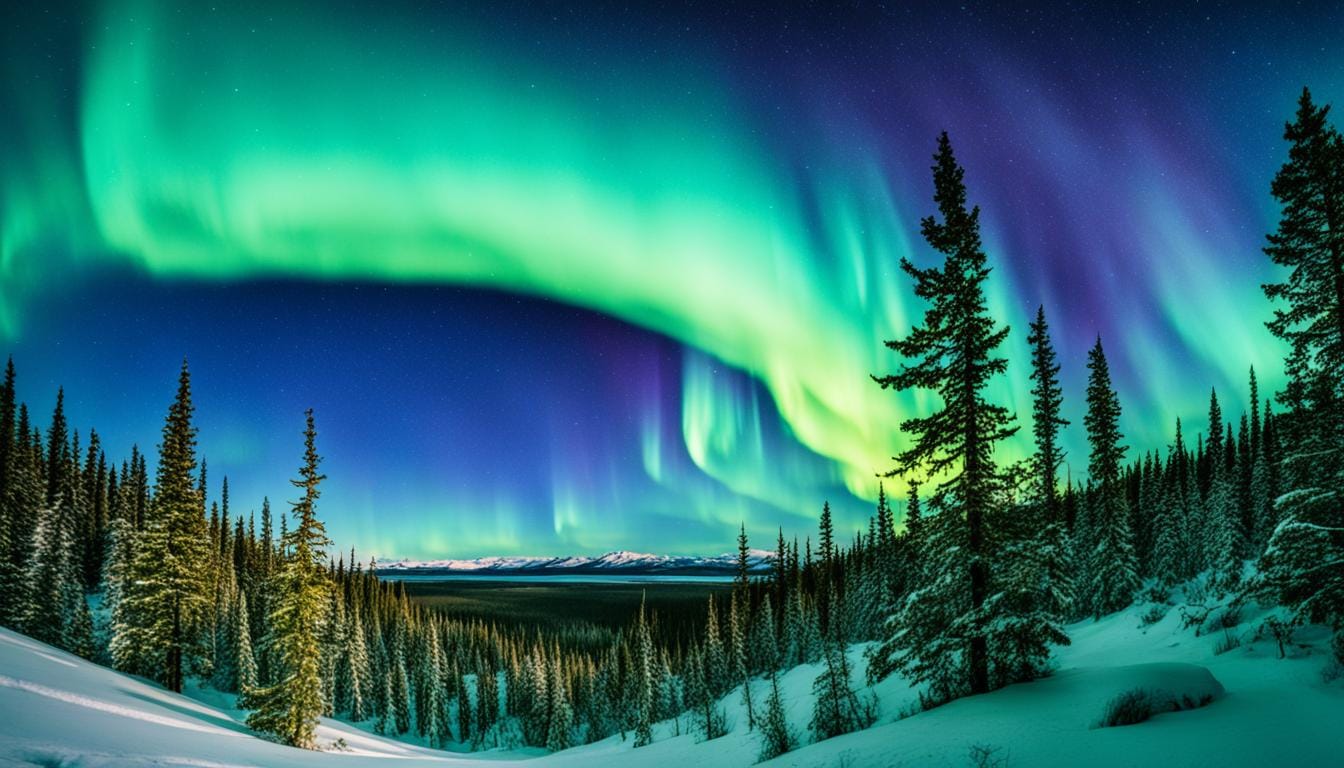Our planet is home to incredible natural events that seem impossible. From fire rainbows to mammatus clouds, these atmospheric displays show nature’s power and beauty. This article will dive into 7 of the most stunning weather phenomena on Earth. It will explain the science behind these amazing sights. By the end, you’ll be amazed by the incredible natural wonders around us.
Introduction to Awe-Inspiring Atmospheric Displays
Our planet is full of natural wonders, thanks to the Earth’s atmosphere. It hosts many captivating weather events. From stunning lightning to beautiful rings of light in the sky, these displays show the power and surprise of our climate. They leave people amazed and curious.
In this article, we’ll look at 7 amazing weather phenomena. These natural sights are not just beautiful. They also teach us about the Earth, its atmosphere, and the universe.
If you love weather, nature, or just the beauty of our world, you’ll find this journey inspiring. It will make you appreciate the incredible forces that shape our climate and environment.
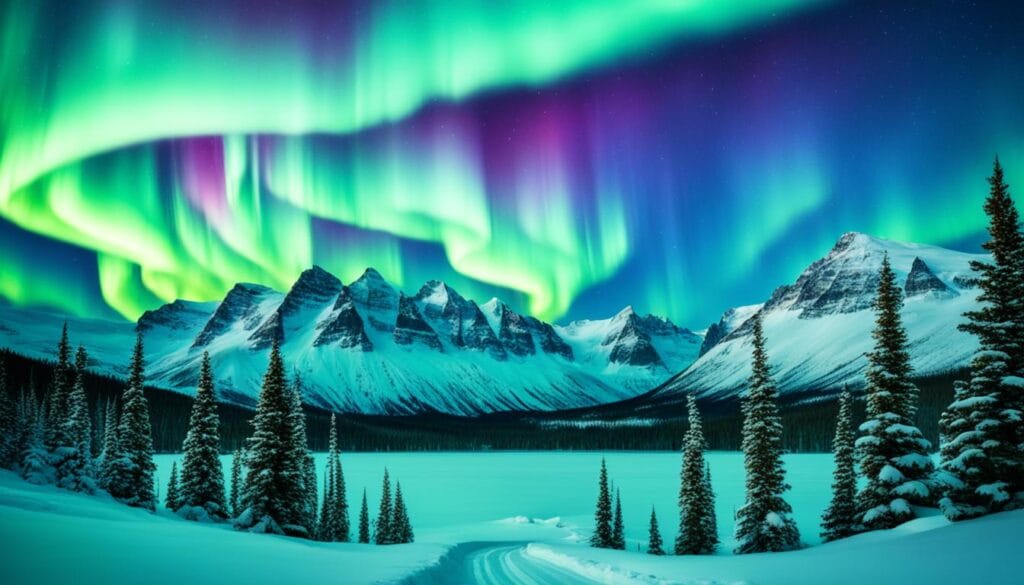
Volcanic Lightning: Nature’s Electrifying Spectacle
Volcanic lightning is a stunning natural event that happens during eruptions. It amazes people with its incredible display. When ash and debris shoot out from the volcano, they rub against each other. This creates a huge amount of static electricity in the cloud.
This electricity then bursts out as volcanic thunderbolts. These create an electrifying spectacle that is truly breathtaking.
The Science Behind Volcanic Thunderbolts
Scientists are still figuring out how volcanic thunderbolts work. But they think it’s because of the ash and fast-moving material in eruptions. The ash friction and static electricity in the cloud cause these amazing volcanic lightning strikes.
Volcanic eruptions are truly a sight to see, with volcanic lightning making them even more impressive. These volcanic thunderbolts show us the incredible power and forces under our feet. They capture our imaginations and show us the beauty of our world.

Halos: Celestial Rings of Light
Halos are amazing optical events that happen when sunlight or moonlight goes through ice crystals in high clouds. These ice crystals bend and reflect the light, making a beautiful ring of light in the sky. Halos can show off colors like a rainbow or just be white.
This beautiful sky display comes from ice crystals in the upper clouds. It’s a natural wonder where light and ice crystals dance together. This dance creates one of the most stunning sights in nature.
The Science Behind Halos
Halos form high up in the sky, above 20,000 feet, in thin cirrus clouds. These clouds have lots of tiny ice crystals. These crystals bend and reflect light from the sun or moon.
The most common halo is the 22-degree halo. It looks like a big ring around the sun or moon, 22 degrees wide. Other halos, like sun dogs and parhelic circles, can also appear based on how the ice crystals are shaped and positioned.
| Halo Type | Description | Causes |
|---|---|---|
| 22-Degree Halo | A large, circular ring around the sun or moon with a radius of 22 degrees | Caused by the refraction and reflection of light through hexagonal ice crystals |
| Sun Dogs | Bright spots of light on either side of the sun | Formed by the refraction and reflection of sunlight through plate-shaped ice crystals |
| Parhelic Circle | A horizontal band of light that can encircle the entire sky | Created by sunlight passing through horizontally oriented ice crystals |
| Circumzenithal Arc | An upside-down rainbow-like arc high in the sky above the sun | Formed by the refraction of sunlight through horizontally oriented ice crystals |
Halos are not just pretty to look at. They can also tell us about the weather. Cirrostratus clouds, which create halos, often mean rain is coming in the next day.
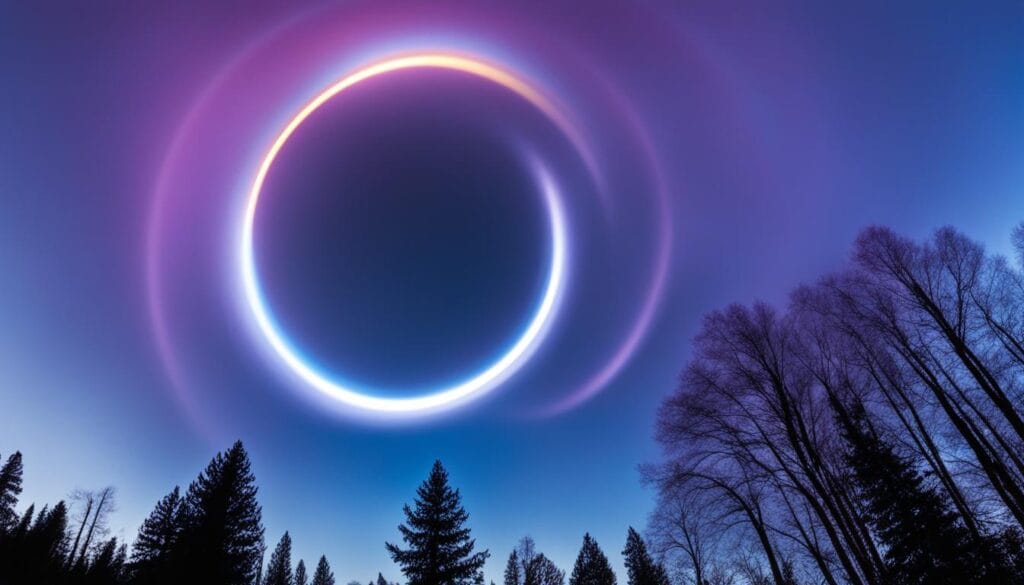
Fire Whirls: Terrifying Tornados of Flame
Imagine a towering column of flames, twisting and swirling like a tornado. This is what fire whirls, or fire tornadoes, look like. They happen when fires and wind patterns meet, creating a huge vortex of fire. This vortex can be as wide as 1,000 feet.
The science behind fire whirls is complex. It involves the intense heat of the fire and air currents. As the fire burns, it creates its own wind patterns. These patterns can be twisted and amplified by the weather, making a spiraling funnel of flame.
Fire whirls can hurt firefighters and make them use emergency shelters. In extreme cases, they can cause huge destruction. For example, a fire whirl in Tokyo in 1923 killed nearly 40,000 people. Recently, the York Fire in California-Nevada grew to over 80,000 acres, with fire whirls adding to the danger.
Fire whirls are powerful and awe-inspiring. They remind us of nature’s raw power. As climate change leads to more wildfires, understanding and preparing for these events is key.
| Statistic | Value |
|---|---|
| Fire tornadoes can range in size | From a few feet to over a hundred feet in diameter |
| Fire tornadoes can occur unpredictably | And grow quickly within minutes |
| Fire whirls can range in size | From less than one meter to three kilometers wide (less than two miles) |
| Fire whirls can present a considerable safety hazard | To firefighters due to their intensity and unpredictability |
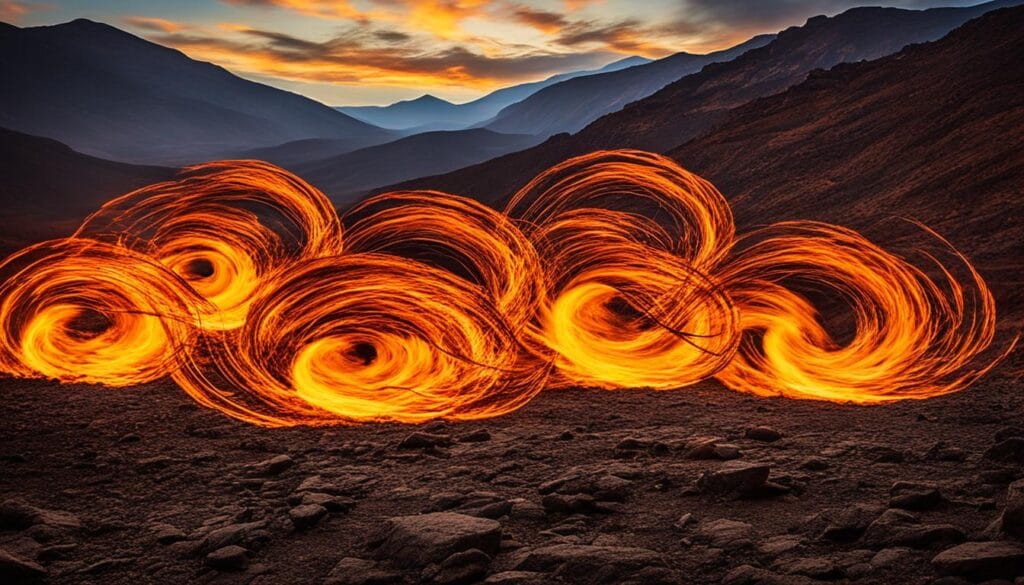
Penitentes: Towering Ice Spikes on High Altitudes
How Penitentes Form and Grow
Penitentes are amazing ice formations that can grow up to 15 feet tall. They are found in the high mountains of the Andes and other places around the world. These ice spikes form when the sun’s rays make small dips in the snow.
As the sun hits these dips, it makes the ice grow taller. This process keeps happening, making the penitentes get taller and taller.
This happens because of the special weather in high places. The sun’s strong rays work with the snow in a unique way. This creates the tall, spiky ice formations we see.
The growth of penitentes depends on many things in the environment. They are more common in places that are very high up. This is where the right conditions are found.
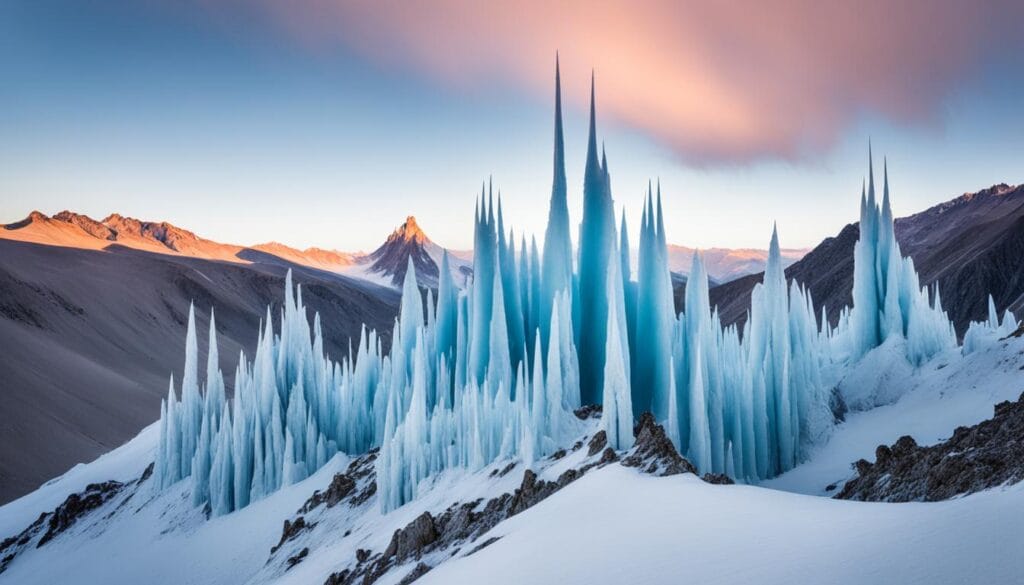
Penitentes don’t form as often as some other snow and ice shapes. But when they do, they can be very tall and interesting. They can affect the weather and climate in high places.
Scientists are studying these ice spikes to learn more about them. They want to know how they form and what effects they have on the environment.
Pele’s Hair: Ethereal Lava Strands
During volcanic eruptions, the wind stretches molten lava into long, thin glass fibers. These strands, up to 6 feet long, are called “Pele’s hair.” They are named after the Hawaiian goddess of volcanoes.
The formation of Pele’s hair shows nature’s power. The wind pulls and stretches the molten rock into glass-like filaments. This creates a mesmerizing display of volcanic activity.
Pele’s hair formation is a captivating example of nature’s artistry. The wind, lava, and volcanic activity work together. They produce ethereal lava strands, showing nature’s incredible power.

Pele’s hair is more than just beautiful. It shows the science behind volcanic eruptions. The wind-stretched lava droplets cool quickly, turning into glass fibers. This creates the thin, ethereal lava strands we see.
For nature lovers, science enthusiasts, or anyone who appreciates beauty, Pele’s hair is awe-inspiring. This display of volcanic eruptions shows the power of nature. It’s a true wonder of our planet, highlighting the mystery and majesty of nature.
Synchronized Cicada Swarms
The Incredible Life Cycle of Periodical Cicadas
North America is home to some amazing natural events. The synchronized emergence of periodical cicadas is one of them. These insects, known as North America’s longest-living insects, live up to 17 years underground. They feed on plant roots.
In 2024, two broods of cicadas will emerge at the same time. One has a 13-year cycle, and the other a 17-year cycle. This event is a wonder of nature, with the last time it happened in 1803. After 2024, these cicadas won’t emerge together again for 221 years.
When the soil gets warm enough, around 64 degrees Fahrenheit, these insects will appear in huge numbers. Trillions of cicadas will come out across America. The males will make a loud buzzing sound, as loud as a motorcycle or jackhammer, during their six-week mating ritual.
Brood XIII cicadas are mostly in the Midwest, like Illinois, Wisconsin, Ohio, and Iowa. Brood XIX cicadas spread wider, covering Missouri, Illinois, Louisiana, North Carolina, Virginia, and Maryland. An app called Cicada Safari helps track these cicadas and study their behavior.
This life cycle, happening every 13 or 17 years, shows the beauty of nature’s rhythms. Cicadas are North America’s longest-living insects. Their synchronized emergence is a true wonder of evolution and adaptation.
Salar de Uyuni: The World’s Largest Mirror
Salar de Uyuni is a stunning natural wonder in Bolivia’s heart. It’s the world’s largest salt flat, covering about 4,086 square miles. This vast salt expanse is even bigger than Utah’s Great Salt Lake.
When it rains, usually from December to April, Salar de Uyuni turns into a giant mirror. A thin water layer on the salt makes the sky and earth seem to merge. This creates an endless, breathtaking view that draws people from all over the world.
Salar de Uyuni is not just a beautiful sight; it’s also a key resource. Underneath the salt, there’s 70% of the world’s lithium, vital for modern batteries. Bolivia, where Salar de Uyuni is, is set to play a big role in the lithium market. This could change the future of renewable energy.
| Feature | Value |
|---|---|
| Size | 4,086 square miles (10,582 km2) |
| Elevation | 3,656 meters (11,995 feet) |
| Salt Reserves | 10 billion tons |
| Lithium Reserves | 70% of the world’s known reserves |
| Seasonal Transformation | Transforms into a reflective lake during the rainy season (December to April) |
Salar de Uyuni is a true wonder of nature. It shows the amazing diversity and beauty of our planet. Whether you’re admiring the mirror-like surface or exploring the salt landscapes, this place will leave a lasting impression.
Combustible Lakes: Nature’s Fiery Pools
There are lakes around the world that can be set on fire. These combustible lakes are in places with long-lasting permafrost. They happen when thermokarst lakes melt and release flammable methane gas. As the permafrost melts, methane bubbles up, making the water potentially ignite.
The science behind these fires shows how our climate, geology, and nature work together. These combustible lakes are both beautiful and dangerous. They warn us of the risks from permafrost melting worldwide.
The Science Behind Methane-Fueled Flames
Combustible lakes form when permafrost melts. Permafrost is a frozen layer of soil and organic matter in cold areas. Climate change makes it thaw, releasing methane, a strong greenhouse gas. This methane can gather in water and ignite with a spark, causing fires.
These lakes show how our natural systems are balanced and how climate change affects them. As the Earth gets warmer, more methane from melting permafrost could increase global warming. This could lead to a cycle that harms ecosystems all over the world.
Pyrocumulonimbus Clouds: Thunderstorms Born from Wildfires
When wildfires rage, something amazing happens: pyrocumulonimbus clouds form. These huge, smoke-filled thunderstorms come from the fires’ intense heat and updrafts. The smoke and ash help create water droplets and ice crystals, leading to towering clouds that can make their own lightning, rain, and even tornadoes.
The link between wildfires and pyrocumulonimbus clouds shows how powerful and unpredictable our weather can be. With more wildfires happening because of climate change, these storms are becoming more common. This brings new challenges for firefighters and those living nearby.
- Pyrocumulonimbus clouds can reach extreme altitudes of 50,000 to 60,000 feet, injecting smoke into the stratosphere.
- These clouds tend to be drier and produce less rain compared to typical thunderstorms, leading to unpredictable fire behavior underneath.
- In the summer of 2021, a single fire in British Columbia generated 700,000 flashes of lightning due to the presence of pyrocumulonimbus clouds.
- Smoke particles from wildfires can contain black carbon, which can result in atmospheric warming when exposed to sunlight at high altitudes.
The creation of pyrocumulonimbus clouds shows how different natural events are connected. As we learn more about these storms, it’s key to use this knowledge in managing wildfires and disaster plans.
Amazing Weather Phenomena: Bismuth Crystals
Bismuth is a shiny metal that forms beautiful crystals. It’s often used in things like safety valves and Pepto-Bismol. But its crystals are a true wonder of nature.
This metal’s unique structure makes it form crystals with amazing patterns and colors. These crystals look like stairs because of their special structure. Artists can make these crystals in a lab by cooling the metal carefully.
Bismuth crystals are not common, but they’re loved by many. Henrikson, a popular TikTok star, has over 1 million followers for his crystal videos. His Etsy shop, “MineralsRockTikTok,” sells beautiful bismuth sculptures. Each sculpture is priced based on its size and beauty.
| Characteristic | Value |
|---|---|
| Bismuth Rarity | Relatively rare in the Earth’s crust |
| Crystal Formation Process | Controlled cooling in a laboratory setting |
| Bismuth Applications | Pharmaceuticals (Pepto-Bismol), lead-free solder, non-toxic ammunition |
| Crystal Geometry | Rhombohedral, resulting in staircase-like patterns |
| Iridescence | Caused by the formation of a thin oxide layer on the crystal surface |
| Crystal Sculptor | Henrikson, a popular social media personality with over 1 million TikTok followers |
The iridescent formations of bismuth crystals show how diverse our planet is, even at a tiny scale. These dense metal crystals amaze and inspire us. They reveal the hidden beauty in nature.
Blood Falls: Antarctica’s Crimson Waterfall
In the dry, desolate lands of Antarctica, there’s a natural wonder: Blood Falls. This crimson-colored waterfall gets its color from an underground lake full of iron. When this iron meets air, it turns the water a deep red.
The iron-rich water comes from an ancient lake under the ice. This lake has been cut off from the outside world for millions of years. When the water hits the surface, it meets sulfur-oxidizing bacteria. These bacteria make the falls look even more like blood.
Blood Falls shows us that life can exist in harsh places. It’s a reminder of the beauty and resilience of nature.
Exploring the Iron-Rich Source of Blood Falls
Thomas Griffith Taylor found Blood Falls in 1911 during the Terra Nova expedition. Since then, scientists have found the waterfall’s hidden source under the ice. They think the ancient seawater flooded this area between 5.5 million and 20,000 years ago.
The Taylor Glacier, home to Blood Falls, is the coldest glacier with flowing water. The water under the ice stays liquid even when it’s freezing outside. This is because the ice releases heat as it forms, and salty water freezes at a lower temperature than fresh water.
A 2019 study found life in the salty waters of the reservoir. This could help us understand how life might exist on other planets like Mars or Europa. Studying places like Blood Falls helps us learn about life’s limits and possibilities.
Rainbow Eucalyptus: Earth’s Most Colorful Tree
The rainbow eucalyptus, found in the Philippines and Indonesia, is a stunning tree. Its bark changes colors in a unique way, showing off greens, purples, reds, and browns. This happens as the outer bark sheds, revealing new, vibrant layers.
As the bark ages, it gets richer in tannins, making it look like a rainbow. This shedding happens often, so the tree’s colors change with the seasons. It’s a sight to behold.
| Statistic | Value |
|---|---|
| Maximum Height | 75 meters |
| Leaf Length | 13 centimeters |
| Commercial Uses | Cellulose production for white paper |
| Native Regions | Philippines, Indonesia |
| Growth Rate | Up to 6 feet per year |
The rainbow eucalyptus is also used for making a lot of white paper. It’s a bit ironic for such a beautiful tree. Yet, it still amazes and inspires people everywhere with its colors.
Eye of the Sahara: The Desert’s Bullseye
In the heart of Mauritania lies the Eye of the Sahara, also known as the Richat Structure. This massive, circular formation is a wonder that has fascinated scientists and space explorers. It spans about 50 kilometers (31 miles) in diameter, making it a striking bullseye in the vast Saharan Desert.
The Eye of the Sahara is thought to be the eroded remains of an ancient dome of rock. It’s made up of concentric bands of different rocks, each wearing away at its own pace. This unique structure has even been a landmark for astronauts, helping them find their way back to Earth.
The size and look of the Eye of the Sahara are truly breathtaking. It towers about 400 meters (1,300 feet) above the desert floor. This geological marvel spans nearly 2,500 square kilometers (965 square miles), with a central depression about 40 kilometers (25 miles) wide.
Many have wondered if the Eye of the Sahara could be the lost city of Atlantis. But, archaeologists and geologists have proven otherwise. They say it’s the result of millions of years of erosion and uplift in the Adrar Plateau of Mauritania.
Even though it’s far away, the Eye of the Sahara has become more popular lately. Its stunning looks and geological importance make it a favorite for space photos and social media posts. This natural wonder shows the incredible variety of our planet’s landscapes, even in the toughest places.
| Characteristic | Value |
|---|---|
| Diameter | Approximately 50 kilometers (31 miles) |
| Area | About 2,500 square kilometers (965 square miles) |
| Central Depression Diameter | Around 40 kilometers (25 miles) |
| Elevation Above Surrounding Terrain | Approximately 400 meters (1,300 feet) |
| First Discovered | By astronauts during the Gemini 4 mission in 1965 |
| TikTok Views | 924.1K |
| TikTok Likes | 28.2K |
Conclusion: Embracing Nature’s Marvels
The Earth is a truly remarkable place, full of natural wonders that amaze and inspire us. From the stunning displays of volcanic lightning to the unique beauty of the rainbow eucalyptus, our planet is full of meteorological marvels. These natural phenomena challenge our understanding and push us to see the world in new ways.
Exploring and appreciating these natural wonders helps us value the complexity and beauty of our world. As we discover more about weather-related phenomena, our sense of wonder grows. This encourages us to see our planet with more respect and awe. These events remind us of the powerful forces that shape our world.
Understanding nature’s marvels can open our eyes to the connections that keep our planet alive. By appreciating these atmospheric displays, we learn to respect our environment. This understanding helps us see the importance of preserving our planet for the future.

